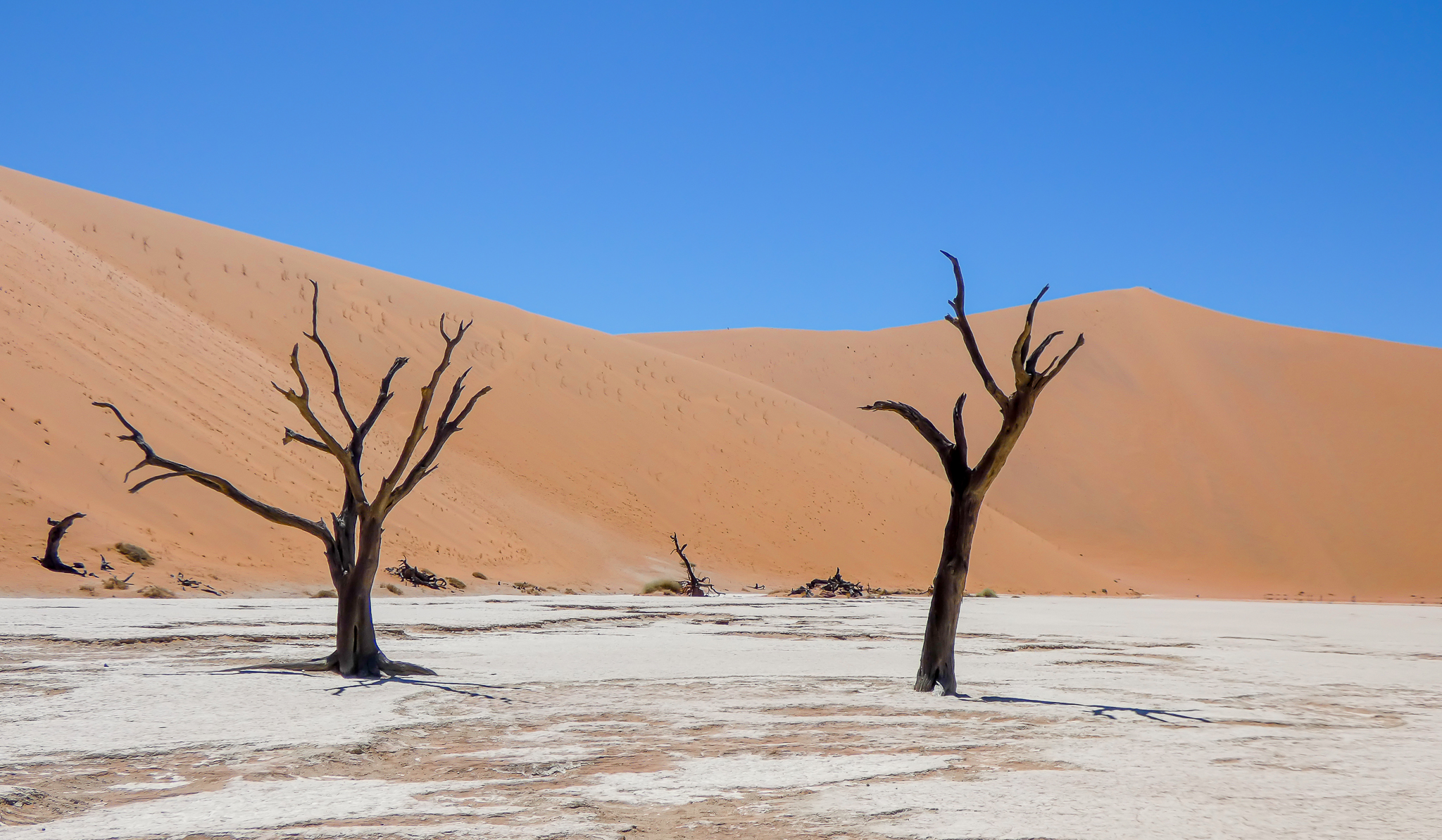
In the first part of the series, I traveled to Sandwich Harbour, the yellow desert on the coast of Namibia. My next journey through the country took me south. I drove along the dusty roads to Sossusvlei, where the deserts turned orange and red. The landscapes there rivaled the ones I saw at Sandwich Harbour — so much so that they are considered the most iconic ones in Namibia.
* * * * *
As I was sitting in the van returning from Swakopmund to Windhoek, I began planning the trip to the south, to see the deserts of the country’s interior and the Fish River Canyon. Not wanting to join a group tour, nor wanting to organize the whole trip myself, I called a local agency to inquire about possibly engaging a driver or a guide for three days. My question surprised them: “You think there is a long line of drivers waiting to take you around? You know this is a big country with few people, right?” I lowered my head in shame. The agent concluded: “Just rent a car and go by yourself. It’s easy.” I caved. When we reached Windhoek, I went to the rental agency Namibia2Go, whose team made it easy indeed. They offered anything from basic-yet-shiny SUVs, which was my choice, to jeeps with camping gear.
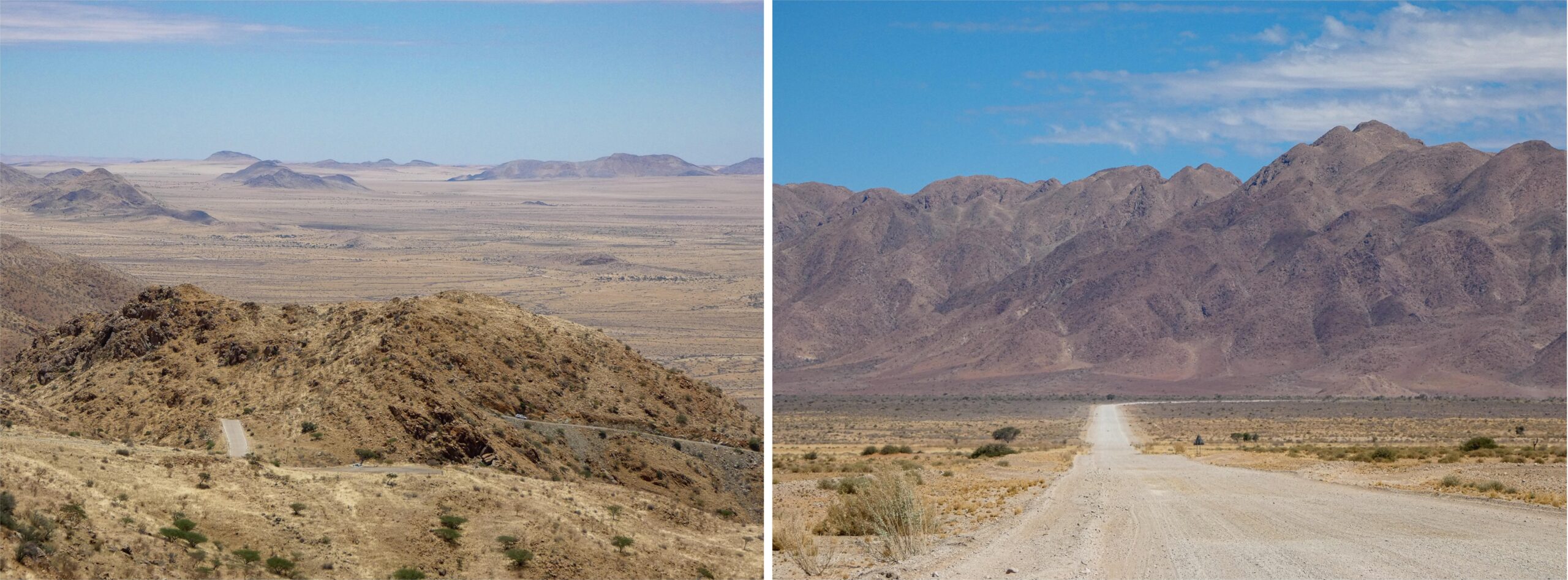
With God on gravel
I picked up supplies in Spar, the go-to Dutch supermarket with a web of malls across Namibia. From Windhoek, I drove south along the paved trunk highway. The journey was smooth until I hit a checkpoint. The policeman on duty looked over my documents and asked about my itinerary. I hoped that his parting phrase, “May God stay with you,” was just a common courtesy.
Soon, my route took me onto a gravel road, toward my first destination. Anxious to follow the rental insurance contract, I deflated my tires somewhat, before speeding up on gravel. I was initially reluctant to rent a car partly due to Namibia’s left-side driving. But that turned out to be a non-issue. The gravel roads were generously wide, and I met cars in the single digits.
I left the capital city and small highway towns far behind me, in another world. The gravel road meandered among farms, which covered immense plots of arid land. Then the hills began, and the road traversed over mountain passes with views of barren landscapes, dotted with rock formations. Along the way, I had flashbacks to drives through the American Southwest. These stopped, however, as soon as I made it to the quintessentially Namibian place — Sossusvlei on the eastern edge of the Namib Desert.
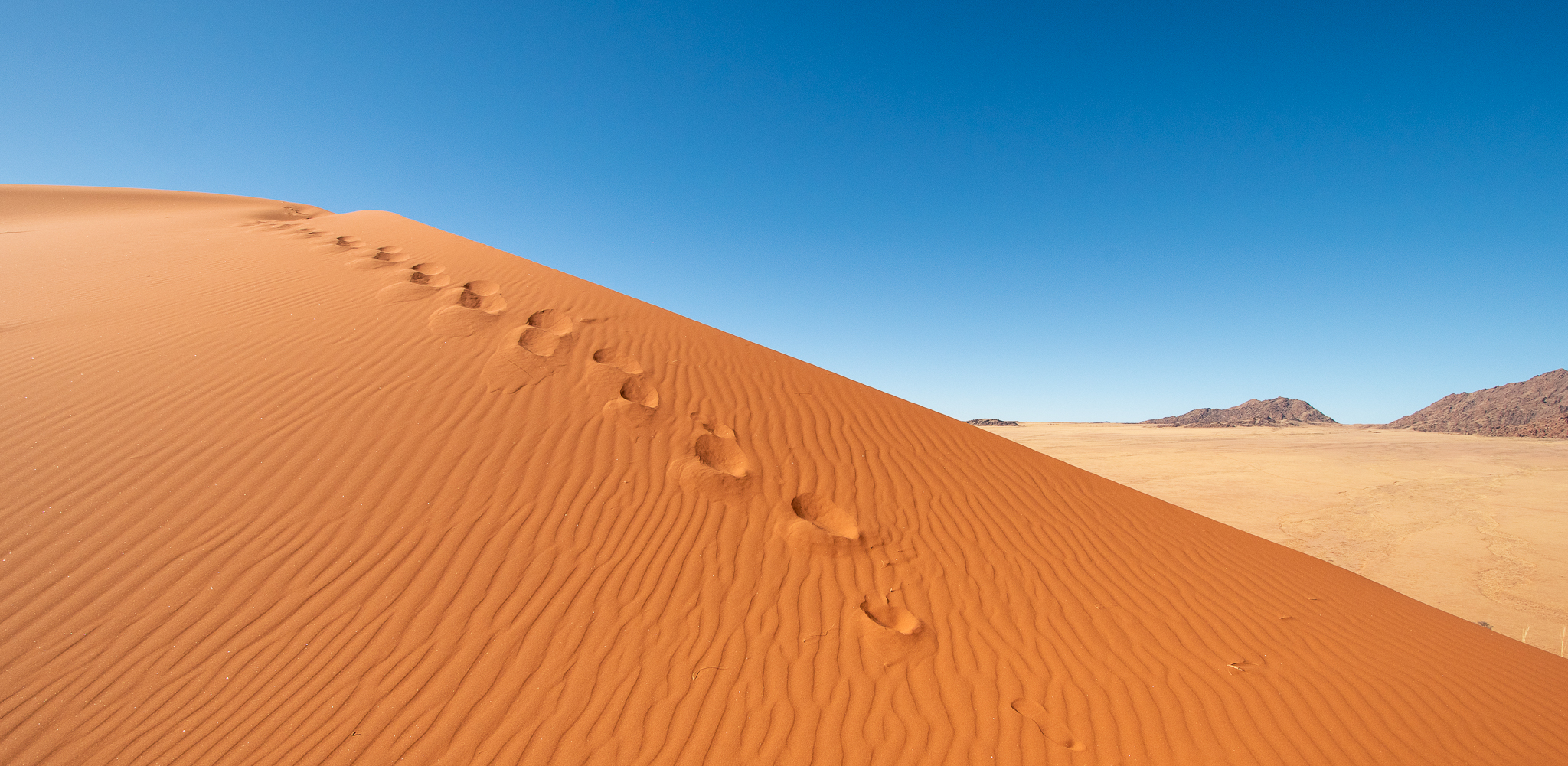
Oryx and nobody
In what was a pattern by then, the name Sossusvlei combines Sossus, the Nama-language word for “dead-end,” and vlei, the Afrikaans for “valley.” Incredibly, Sossusvlei belongs to the same gigantic Namib-Naukluft National Park as Sandwich Harbour. The vast area of the park is covered with sand dunes from the western shore all the way to the deep interior. Driving between the two ends of the park can therefore be done only by circumnavigating its entire territory.
It was late afternoon already, but I was eager to get a sneak peek of Sossusvlei. So, I drove to the Elim Dune right behind the park boundary. I left my car in a large lot that was completely empty and climbed up the dune. The red sand appeared incredibly vivid at that time of the day. Since I was the only human around, the dune had a blanket of intact grooves shaped by wind, and its edge was perfectly smooth. I felt guilty about leaving my traces on the natural piece of art.
The sharp December sun made me sweat, and the red grains began to stick to my calves. But the view from the top made it worth it. The red of the dune looked even more beautiful in contrast to the dry plain below and the dark Naukluft Mountains on the horizon.
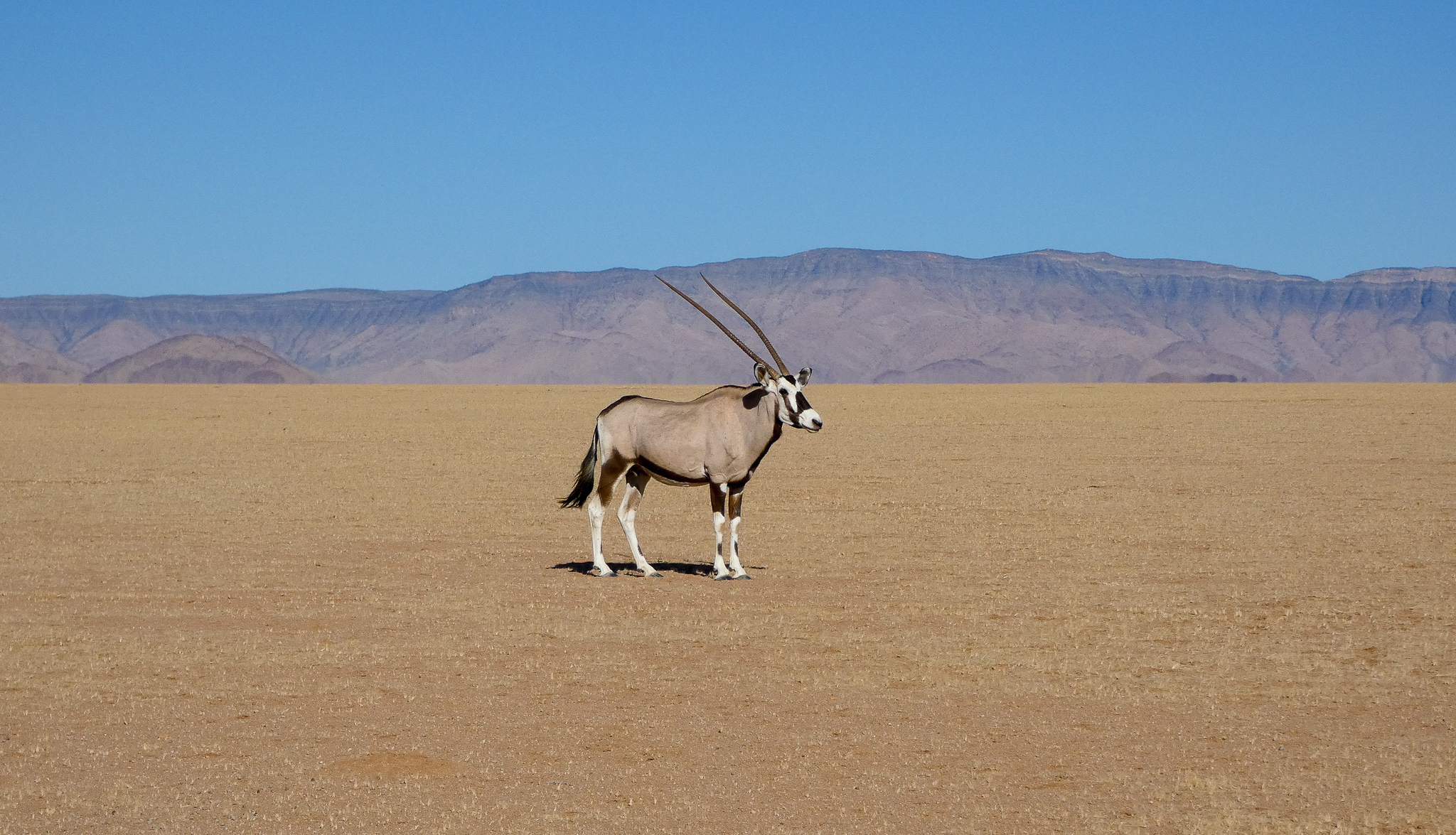
I had the dune all for myself. Only when I was returning to the car did I notice living creatures. A spider leaving its tiny traces on the sand, and then an oryx, with its long horns, braving the heat on the plain.
Stars and trees
I made it to the lodge where I was going to stay. As I began to talk to the people there, I realized how few humans I had come across that day. Namibia is a vast, safe space for introverts, and even the oryx I saw at the Elim Dune was entirely on its own.
The lodge offered dining at a campsite a few miles out, which I drove to and began eating the obligatory meaty meal. Nighttime fell and Ziggy, one of the supervisors at the camp, started to comment on what appeared above our heads — a black dome filled with shiny stars, which absolutely lived up to travel cliches about observing a night sky in the desert. Turning my head in all angles, I was overwhelmed. I asked Ziggy if he would point to the Southern Cross. That was easy for him, and what followed were stories about other star clusters above. “How do you know all those things about stars?” I asked. “Nothing special. I just used to sit outside with my grandfather and his friends at night. They kept talking about the stars, and I listened.”

In the morning, I inquired whether the lodge had a day tour into Sossusvlei. I had heard it might require some driving on the sand. No tour, but Ziggy was going to Sossusvlei with a few colleagues in case I wanted to join. “Yes, of course!”
I sat next to Ziggy as he was driving our van, and I asked a few touristy questions: “Are dangerous animals around here?” Ziggy obviously knew what kind of stories I was looking for. “Yes, we have a leopard occasionally in the area. Last year, we found the skeleton of a calf. It was up on a tree near the lodge. That’s how we knew the leopard was visiting.” My satisfied reaction encouraged him. He pointed to a solitary tree we were passing. It had an extended branch from which a gigantic sack of dried grass was hanging. I had stopped at a similar tree the day before, to see it close up and to take a picture. Ziggy said: “That’s a nest, created by small birds. The ones you see flying in and out. They take many years and many generations to build it up.” It was impressive indeed. “But never walk under the nests.” “Why?” I gulped. “There is often a patch of grass underneath with a cobra hiding there. It’s waiting for a birdie to fly low.”
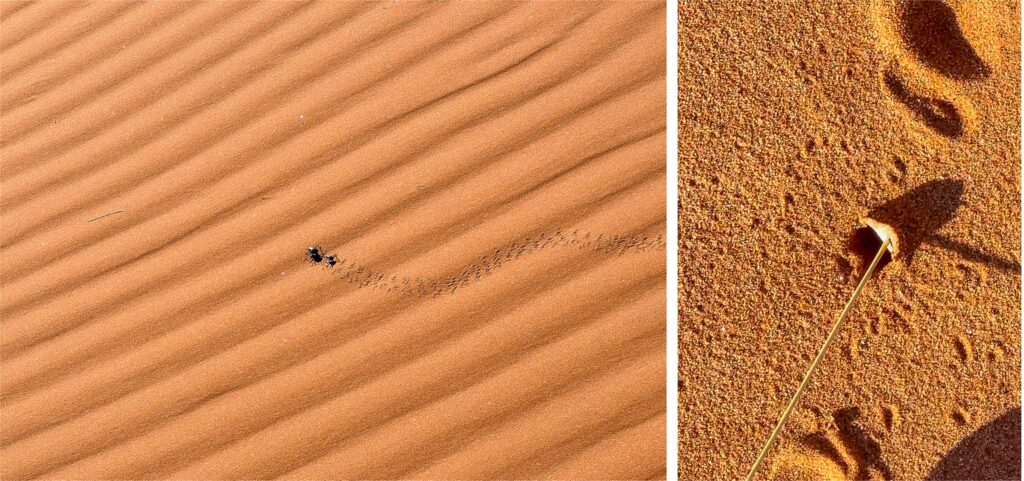
Little wonders
I was chatting with Mathias, one of Ziggy’s colleagues in the car as we entered Sossusvlei. We had to report national origins of passengers at the gate and when Ziggy said four Namibians and a foreigner, I protested, pointing to my cap with Namibian flag. Ziggy laughed and took the discussion about ancestry further: “I speak RuKwangali, Mathias is Oshiwambo, and the ladies are Nama and Himba. So, you are here with all of Namibia.” “And I assume you all moved here for work, from the north?” “Three of us did.”
We drove past the Elim Dune, and soon, more and more red sand surrounded us. Ziggy stopped at a seemingly random place. We took a few steps from the car, and he looked around, asking: “So, what happened here overnight?” He pointed to the lines of traces that crisscrossed the sandy field. “From this, we see which animals walked where. We call it the morning paper.”
His eyes zoomed in on a particular path, and his finger followed it. A few interruptions in the tiny traces made his search difficult, but eventually, he found what he was looking for. He picked up a straw of dry grass and, with clinical precision, stuck it into the sand. He angled the straw, and incredibly, it opened a tiny lid made of sand that was glued together with white silk from below. The lid was about a half an inch in diameter. Under the lid, we could see a tight tunnel. “This is where the lady lives,” Ziggy said. He was talking about the white lady spider, a species of spider almost exclusively found in the Namib desert. “The trace leading here was a male who approached her at night. For mating, they must tap on the lid in a special way. If they mess up, she eats them!” After we finished with all the obvious jokes, I realized that nowhere else but in the Namibian deserts have I paid such attention to nature’s little wonders.
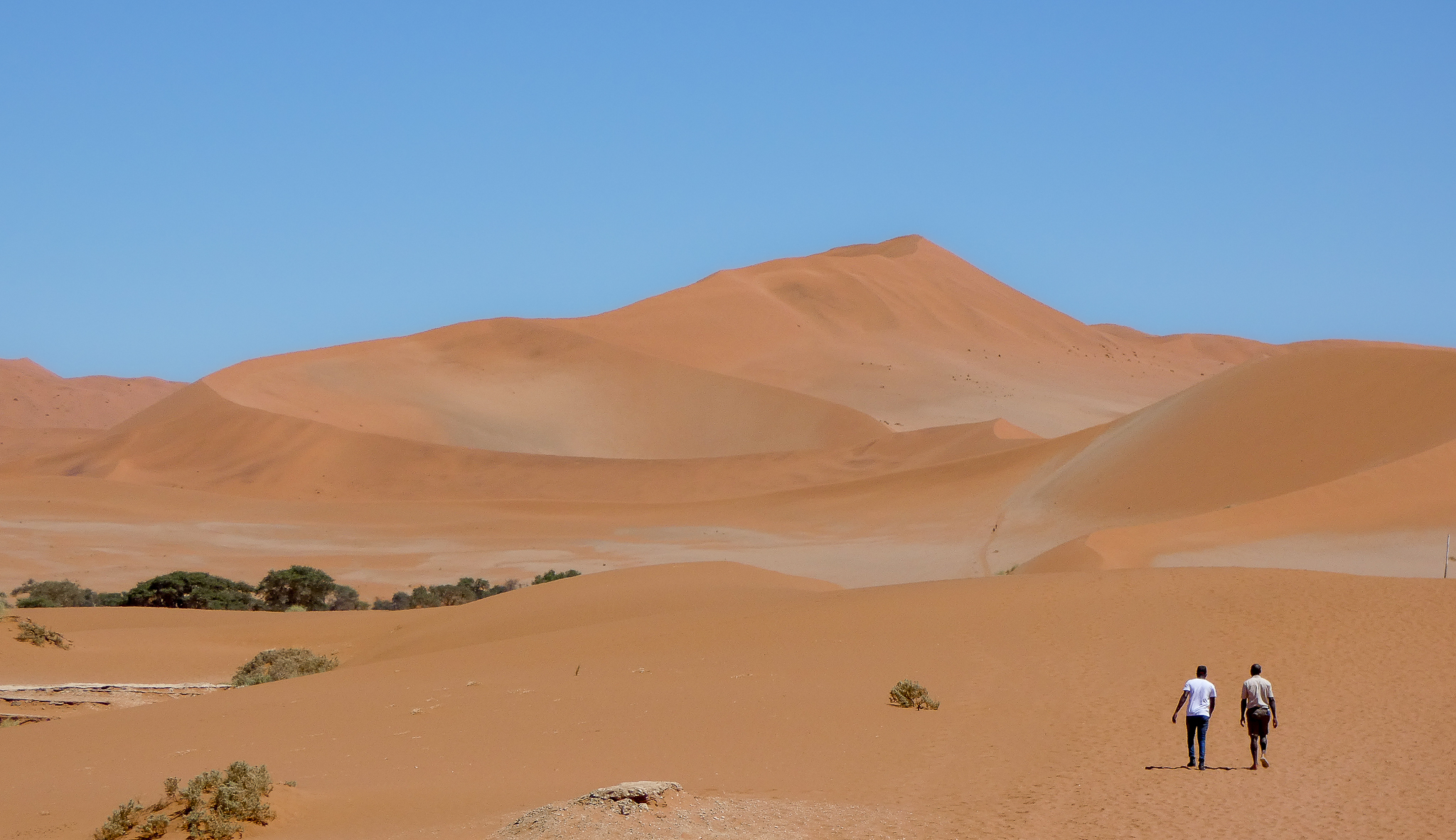
Ocean of red
Driving deeper into Sossusvlei, we paused at larger dunes, which usually had names. One was Dune 45, whose name counts kilometers from the park entrance. The peak of Dune 45 rises more than one hundred meters (three hundred feet), and some early visitors were already climbing it. We, however, kept going until we reached the tallest dune of Sossusvlei.
The dune is called Big Daddy and its height is reported at 325 meters (1066 feet). As we were about to climb it, the others in our group voiced their relief that the sky was cloudy. I was upset that my pictures would not contain any blue. Ziggy comforted me: “You don’t have to worry about that.”
We took our shoes off quickly on the loose sand. From the previous days, I knew that climbing a sandy slope was hard, but I was still surprised by how challenging Big Daddy was. My long legs and perceived good shape were no help. Every step upward moved me only slightly as the foot slid down and diminished any progress. Mathias, who was younger, ran up easily, and Ziggy, roughly my age, walked much faster without sweat. First, I climbed with the young ladies from our group, but soon, we all spread out along a never-ending dune edge that kept pointing upwards.
The walk was so long that the clouds had time to disperse. I got some blue sky when I emerged at the top and reunited with our group. We were taking pictures of each other, and Mathias encouraged me to pose with my right-hand fingers visibly pointing downward, but my thumb separated from them at a right angle. “Your hand will look like a map of Namibia that way.”
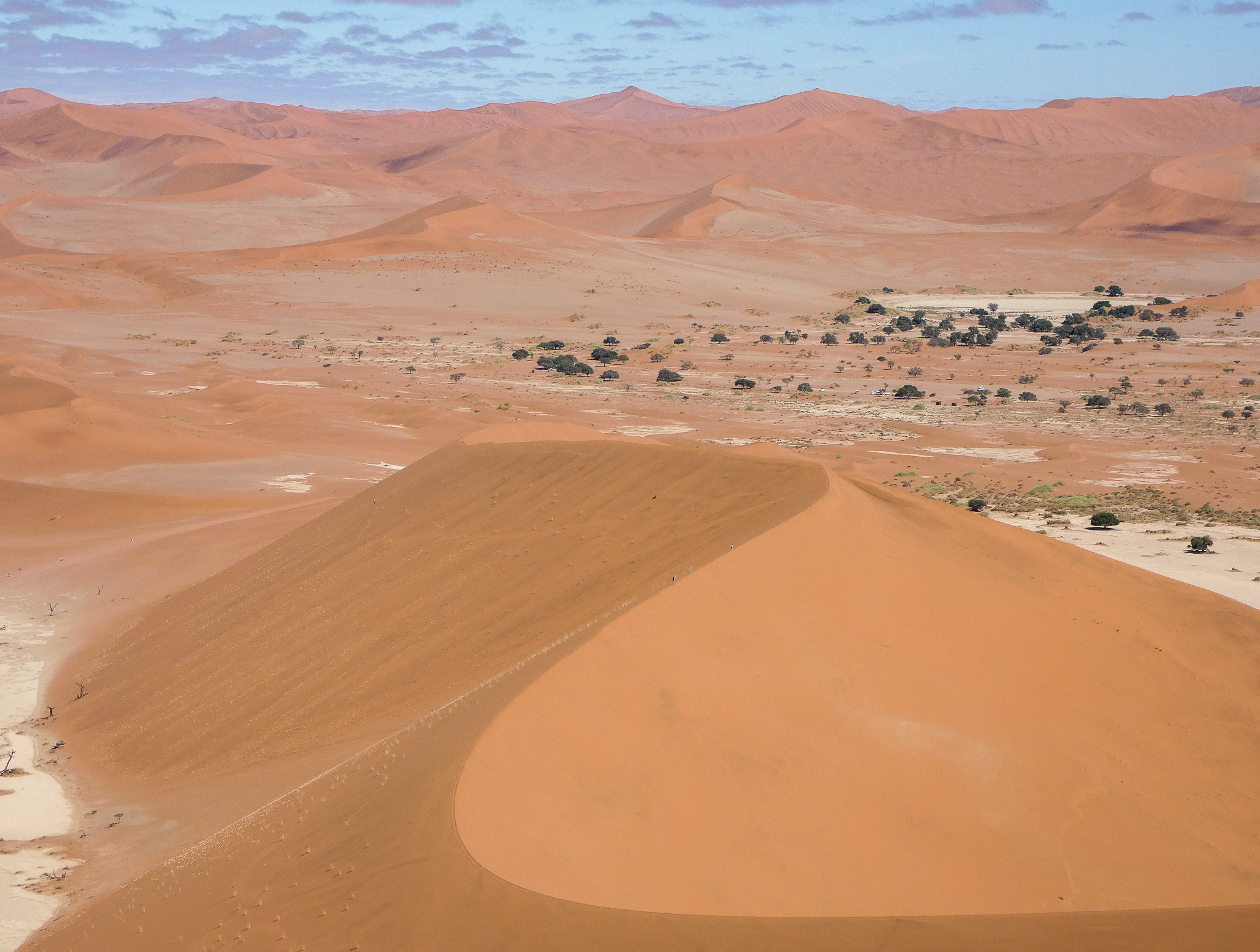
We were the only ones up there, with other tourists coming much later. That gave us quiet moments to stare at the ocean of dunes below, which sparkled in orange and red.
Intriguingly, Sandwich Harbour, with its bright yellow dunes, was just a few dozen miles behind the horizon. The colors morph from yellow to red over the distance as the iron coating of the grains becomes more prominent. Why the inland desert has more iron is not clear. There are scientific studies and hypotheses — some suggest that older dunes have accumulated more iron — but there is no definitive explanation.
The awe effect rivaled the one at Sandwich Harbor. In a similar way, Sossusvlei overpowered me not only for its unique visual beauty. Afterall, there are plenty of photogenic deserts around the world. It was the remoteness that made the place feel different. It took dedication to just get to Sossusvlei — it is a faraway wonder even for northern Namibians. And then, not all climbers make it to the top of Big Daddy. I looked down and my bare feet were buried in the sand, the only matter that covered the Earth there. I sensed an intense physical connection with the place.
Ziggy ended our stay at the top with “let’s run down there,” pointing to a white plain among the dunes below. Mathias ran first. Only when I watched his figure become smaller and smaller on the sandy slope did I appreciate how high we were. It is easy to lose a sense of scale on the dunes. I ran down, too, and although it was much easier than the ascent, it took me some time.
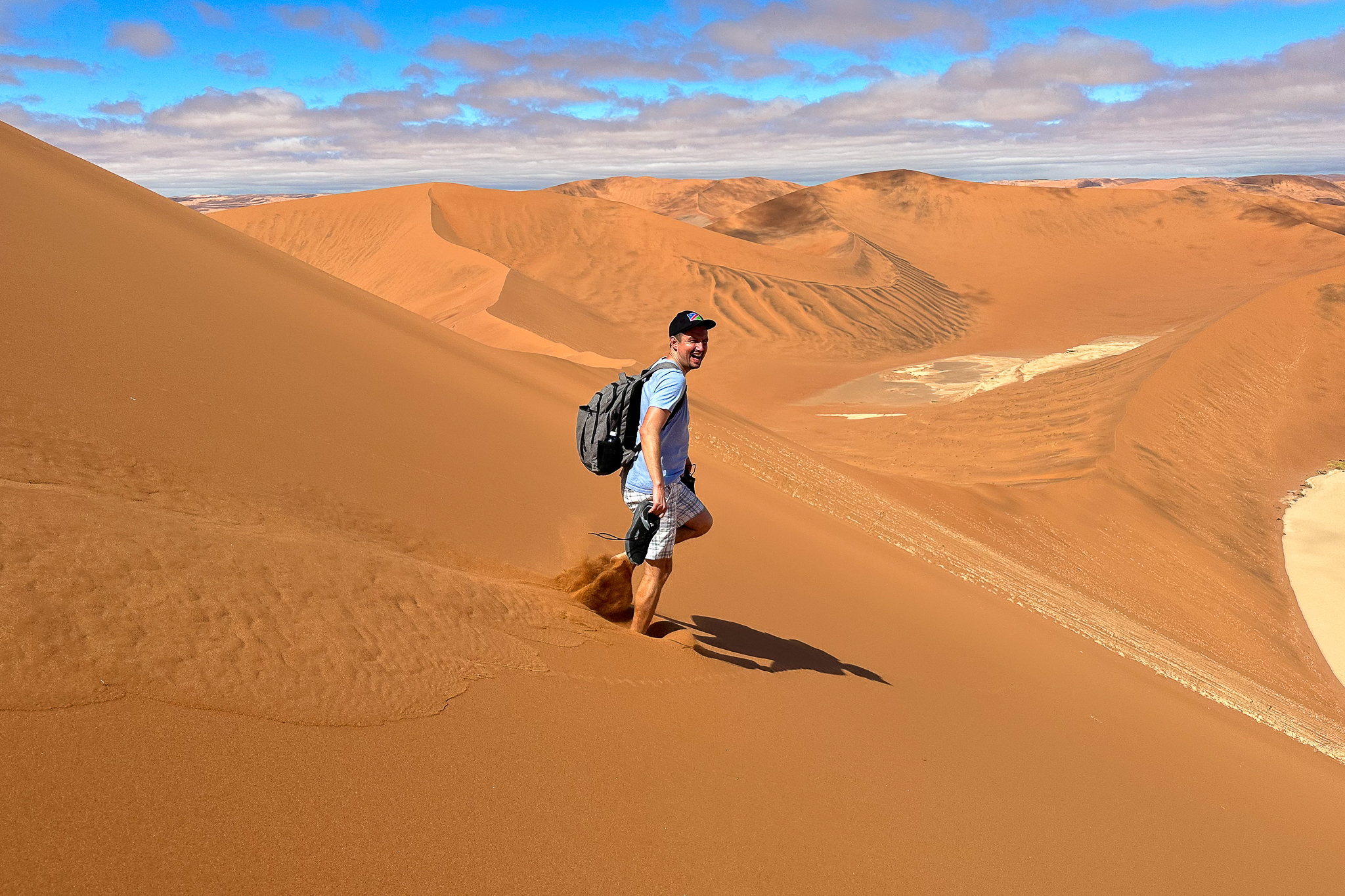
Dead beauty
I was wrong to think that Big Daddy was the highlight of the day. Walking across the white plain at the bottom extended my sense of exhilaration. The plain is called Deadvlei, a completely Afrikaans name meaning Dead Valley. It looks like what the name says, but it is arranged in a way that would shame even the most creative artist.
In the distant past, the valley was lush with trees that flourished thanks to a stream of water feeding them. The wind then destroyed the valley. It blew sand into the stream and progressively cut the valley off from its water source. The muddy bottom dried out and cracked into a white mosaic of thousands of pieces. Most intriguingly, the dead, leafless trees are still there, with blackened branches.
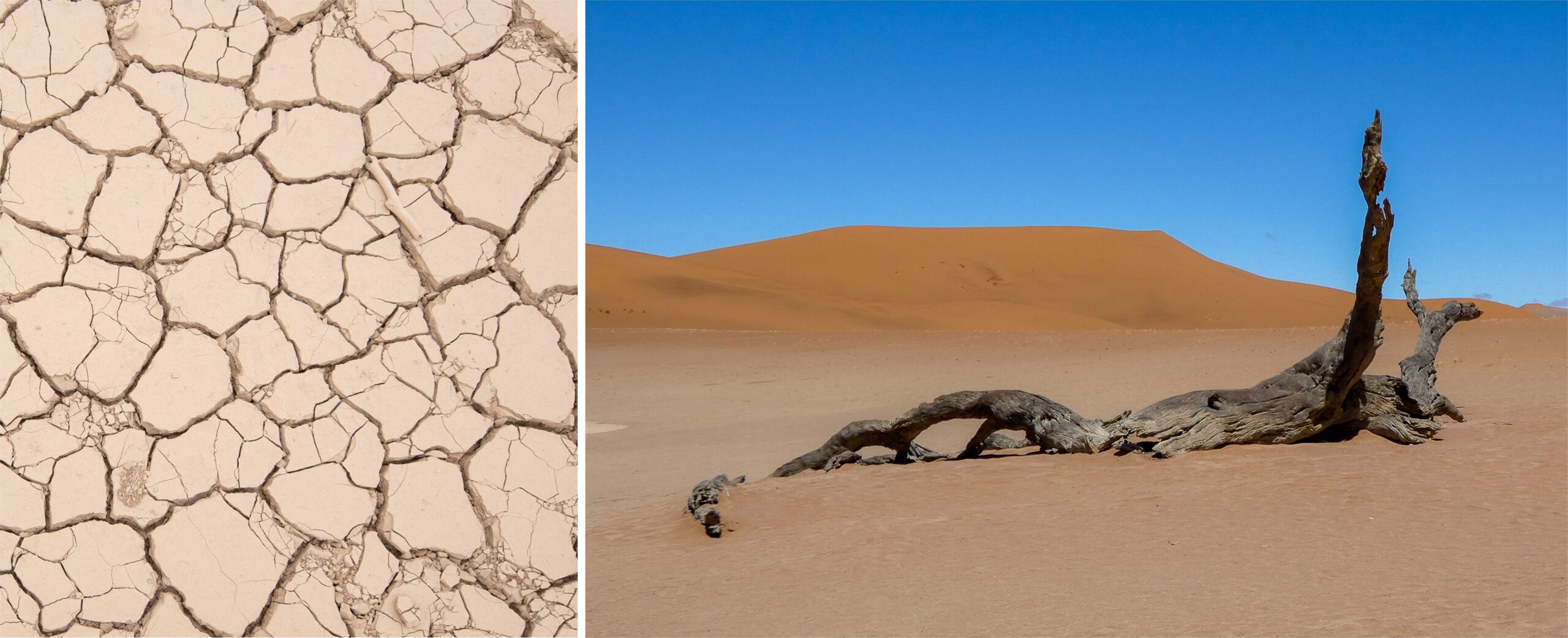
The scenery of a white floor with black trees would be stunning enough, but then, it is surrounded with the red walls of Big Daddy and his arms. Above that was a suddenly clear blue sky. If there is one iconic picture of Namibia, it is undoubtedly Deadvlei.
Hot and cool places in the desert
We made it to the car, and as we were returning to the main dusty road, our jeep would not move. It got stuck in the sand. Rotating the wheels buried them only deeper. How happy I was I did not go to Sossusvlei on my own. We were saved by a few dry branches that lied close to us. With his hands, Ziggy removed the sand from around the wheels and placed the branches into the path of the car. He got behind the driving wheel while Mathias and I were trying to push the car as much as possible. The desert sun I had been craving was making the effort less pleasant, but soon enough the car got unstuck, and we were liberated.
Our last stop was Sesriem Canyon, a narrow gorge of sandstone, about thirty meters deep (a hundred feet). It was carved by a creek that does not completely dry out because it is shielded from hot air above by the canyon walls. We walked down to the canyon floor, and Ziggy took us to pools of standing water: “This is where baboons come to drink.” We roamed the canyon a bit longer, and I kept looking at the rock formations full of clefts. Those were the only cool hideouts for those animals that cannot dig tunnels in the sand.
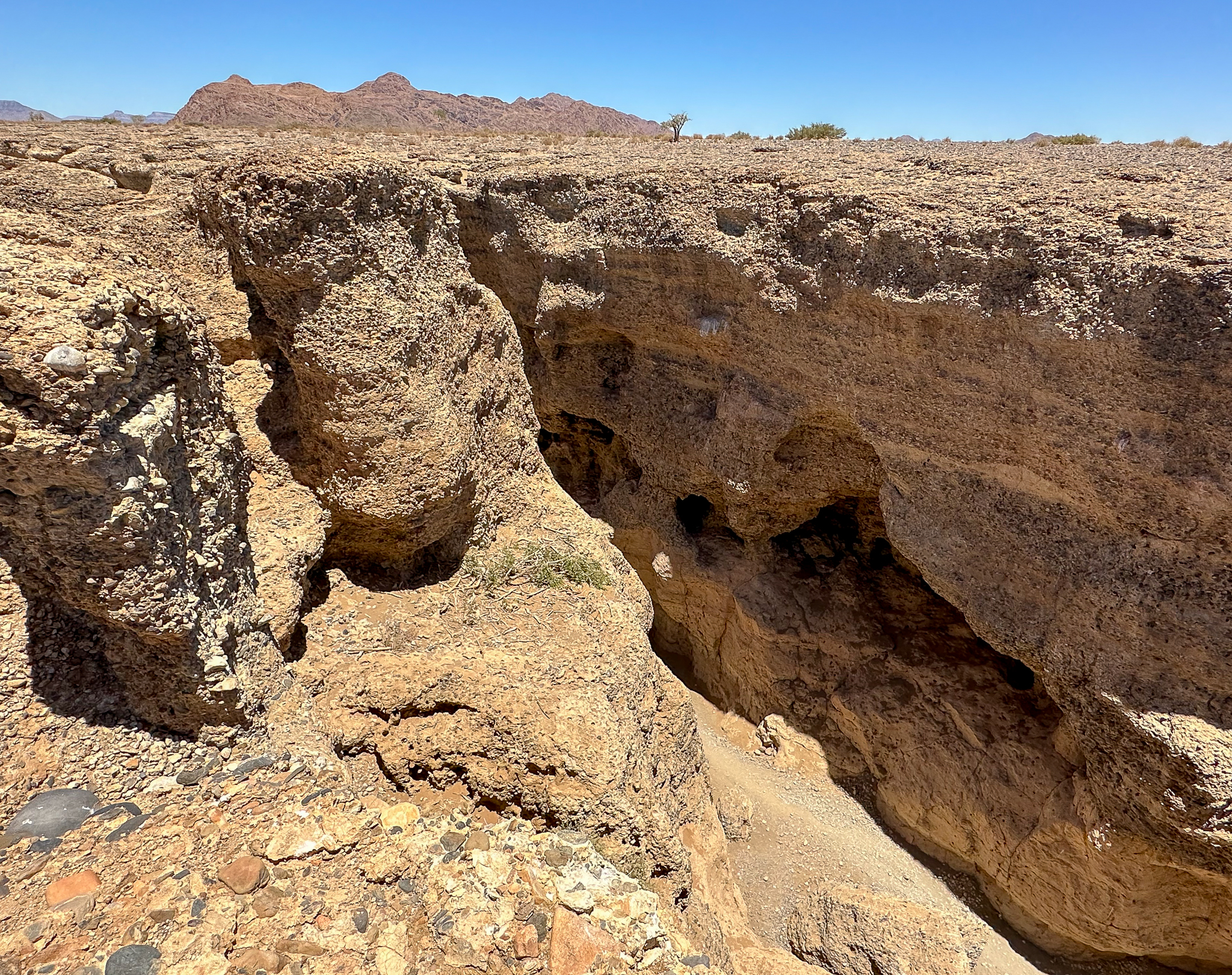
Hard to let go
We made it back to the lodge and I decided that for dinner, I would give my body a break from the cycle of heavy meat. I asked for green salad from the menu. As I began to crunch on the leaves, I noticed black, dry squares. “What is this?” I asked. “Biltong from oryx,” was the answer. Well, the salty biltong made the salad tasty, so I just gave in.
I departed the lodge the next morning, heading for the very south of the country. I had to leave behind the new friends I had just made. I came to Namibia to savor solitude, and yet, I felt sadness when I was in the car on my own again.
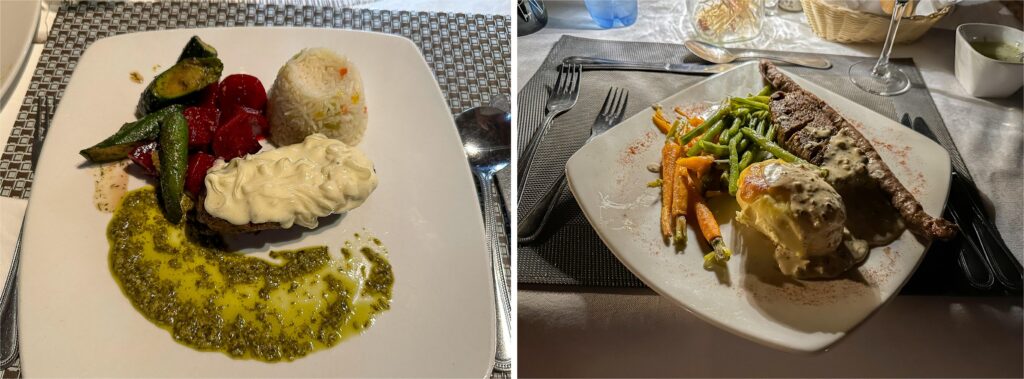
Part 3 of the Namibia series
At the end of my trip, I finally made it to the Fish River Canyon. The deserts along the way, however, ended up being even more enchanting than the place I came to Namibia to see.
If you go
Car rental: Namibia2Go agency https://namibia2go.com/
Sossusvlei: visitor information https://www.sossusvlei.org/about/; among many lodges, this is the one where I stayed https://the-elegant-collection.com/desert-lodge.html; if your lodge does not organize a tour of Sossusvlei, here you can book a jeep trip to the dunes https://www.sossusvleilodge.com/sossusvleiexcursion.html
This article was previously published on TravelExaminer.net, where you can view dozens of award-winning national and international travel destination articles:
